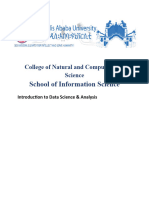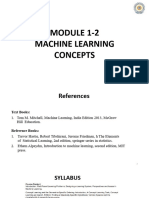Machine Learning
Uploaded by
reachudaycMachine Learning
Uploaded by
reachudaycMachine learning is a subset of artificial intelligence (AI) that focuses on
developing algorithms and techniques that enable computers to learn from and make
predictions or decisions based on data without being explicitly programmed. It's a
rapidly growing field with applications in various domains, including healthcare,
finance, marketing, transportation, and more. Here's an introduction to key
concepts in machine learning:
Definition: Machine learning is the process of training algorithms to recognize
patterns and make decisions based on data. It involves providing the algorithm with
a large amount of data (training data), allowing it to learn from examples, and
using this learned knowledge to make predictions or decisions on new, unseen data.
Types of Machine Learning:
Supervised Learning: In supervised learning, the algorithm is trained on labeled
data, where each example in the training dataset is associated with a corresponding
label or outcome. The algorithm learns to map input data to output labels by
minimizing the difference between predicted and actual outcomes.
Unsupervised Learning: In unsupervised learning, the algorithm is trained on
unlabeled data, and its goal is to uncover hidden patterns or structures within the
data. Common tasks in unsupervised learning include clustering similar data points
and dimensionality reduction.
Reinforcement Learning: In reinforcement learning, the algorithm learns to make
decisions by interacting with an environment and receiving feedback in the form of
rewards or penalties. The algorithm learns to maximize cumulative rewards over time
by taking actions that lead to favorable outcomes.
Key Components:
Features: Features are the input variables or attributes used to describe each
example in the dataset. Feature selection and engineering play a crucial role in
determining the performance of machine learning models.
Model: The model is the mathematical representation of the relationship between
input features and output labels. Different machine learning algorithms use
different models to make predictions or decisions.
Loss Function: The loss function measures the difference between predicted and
actual outcomes and serves as a guide for adjusting the model parameters during
training.
Optimization Algorithm: The optimization algorithm is used to minimize the loss
function and optimize the model parameters. Common optimization algorithms include
gradient descent and its variants.
Applications:
Classification: Classification tasks involve predicting discrete class labels or
categories for input data. Examples include spam detection, image classification,
and sentiment analysis.
Regression: Regression tasks involve predicting continuous numerical values for
input data. Examples include house price prediction, stock market forecasting, and
demand forecasting.
Clustering: Clustering tasks involve grouping similar data points together based on
their characteristics. Examples include customer segmentation and anomaly
detection.
Recommendation Systems: Recommendation systems use machine learning techniques to
suggest relevant items or content to users based on their preferences and past
interactions.
Machine learning is a powerful tool for extracting insights from data, automating
tasks, and making data-driven decisions. It continues to advance rapidly, with
ongoing research and development leading to new algorithms, models, and
applications.
You might also like
- Introduction_to_Machine_Learning_ConceptsNo ratings yetIntroduction_to_Machine_Learning_Concepts1 page
- In Depth Explanation of Machine Learning ConceptsNo ratings yetIn Depth Explanation of Machine Learning Concepts3 pages
- Machine Learning: A Comprehensive OverviewNo ratings yetMachine Learning: A Comprehensive Overview3 pages
- Introduction To Machine Learning PPT MainNo ratings yetIntroduction To Machine Learning PPT Main15 pages
- A Comprehensive Guide to Machine LearningNo ratings yetA Comprehensive Guide to Machine Learning8 pages
- Machine Learning And Deep Learning With Python A Beginners Guide To Programming - 2 Books In 1No ratings yetMachine Learning And Deep Learning With Python A Beginners Guide To Programming - 2 Books In 1132 pages
- Class Notes: The Basics of Machine LearningNo ratings yetClass Notes: The Basics of Machine Learning4 pages
- Machine Learning Fundamentals- A Beginner’s GuideNo ratings yetMachine Learning Fundamentals- A Beginner’s Guide2 pages
- Introduction To Machine Learning Algorithms - ScribdNo ratings yetIntroduction To Machine Learning Algorithms - Scribd2 pages
- Machine Learning Intro for Absolute BeginnersNo ratings yetMachine Learning Intro for Absolute Beginners3 pages
- Lec 1-2 Notes Introduction To Machine LearningNo ratings yetLec 1-2 Notes Introduction To Machine Learning7 pages
- Article 1 - Understanding Machine Learning - Concepts and ApplicationsNo ratings yetArticle 1 - Understanding Machine Learning - Concepts and Applications3 pages
- 2. Fundamentals of Machine Learning- A Comprehensive IntroductionNo ratings yet2. Fundamentals of Machine Learning- A Comprehensive Introduction14 pages
- Machine Learning Tutorial For BeginnersNo ratings yetMachine Learning Tutorial For Beginners15 pages
- MACHINE LEARNING FOR BEGINNERS: A Practical Guide to Understanding and Applying Machine Learning Concepts (2023 Beginner Crash Course)From EverandMACHINE LEARNING FOR BEGINNERS: A Practical Guide to Understanding and Applying Machine Learning Concepts (2023 Beginner Crash Course)No ratings yet
- Machine Learning Algorithms for Data Scientists: An OverviewFrom EverandMachine Learning Algorithms for Data Scientists: An OverviewNo ratings yet
- K-Means and ISODATA Clustering Algorithms For Landcover Classification Using Remote SensingNo ratings yetK-Means and ISODATA Clustering Algorithms For Landcover Classification Using Remote Sensing4 pages
- Darcet 2023 Vision Transformers Need RegistersNo ratings yetDarcet 2023 Vision Transformers Need Registers16 pages
- Artificial Intelligence, Machine Learning and Smart Technologies For Nondestructive EvaluationNo ratings yetArtificial Intelligence, Machine Learning and Smart Technologies For Nondestructive Evaluation17 pages
- Supervised and Unsupervised Learning: Ciro Donalek Ay/Bi 199 - April 2011No ratings yetSupervised and Unsupervised Learning: Ciro Donalek Ay/Bi 199 - April 201169 pages
- AI-417-IX Unit 1 Project - Cycle - Notes Session 2No ratings yetAI-417-IX Unit 1 Project - Cycle - Notes Session 213 pages
- Chapter 1 Introduction To Machine Learning100% (1)Chapter 1 Introduction To Machine Learning19 pages
- Semi-Supervised K-Means Ddos Detection Method Using Hybrid Feature Selection AlgorithmNo ratings yetSemi-Supervised K-Means Ddos Detection Method Using Hybrid Feature Selection Algorithm15 pages
- AI Driven Smart Homes Energy Efficiency and ModelNo ratings yetAI Driven Smart Homes Energy Efficiency and Model7 pages
- Ccs355 Neural Networks and Deep Learning Unit1 (1)No ratings yetCcs355 Neural Networks and Deep Learning Unit1 (1)29 pages
- DEEP LEARNING & IMAGE PROCESSING [DAY-1 NOTES]No ratings yetDEEP LEARNING & IMAGE PROCESSING [DAY-1 NOTES]18 pages
- 2021 Artificial Intelligence in HypertensionNo ratings yet2021 Artificial Intelligence in Hypertension19 pages
- Data Analytics For Forecasting Cell Congestion On LTE NetworksNo ratings yetData Analytics For Forecasting Cell Congestion On LTE Networks6 pages
- Introduction To Machine Learning: Dr.S.Sankar Ganesh Vellore Institute of TechnologyNo ratings yetIntroduction To Machine Learning: Dr.S.Sankar Ganesh Vellore Institute of Technology132 pages
- Introduction To Machine Learning - Midterm Quiz 2No ratings yetIntroduction To Machine Learning - Midterm Quiz 211 pages

























































































